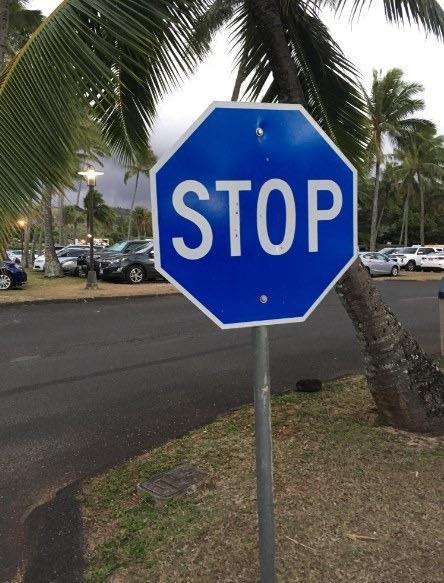The Blue Stop Sign of Maple Grove
In the small, secluded town of Maple Grove, tucked away behind a high stone wall and a wrought-iron gate, there was a secret that puzzled even the most meticulous observers. Among the neatly trimmed hedges and perfectly paved driveways of the gated community, a single blue stop sign stood at the entrance of the parking lot. It wasn’t a sign issued by the U.S. Department of Transportation, nor was it part of the conventional red, white, and black array that governed public roadways. Yet there it hung, a beacon of unconventional order amid the chaos of modern life.
A Curious Discovery
For as long as anyone could remember, Maple Grove prided itself on its quiet, orderly existence. The community, built decades ago as a private retreat for families seeking solace from the busy urban sprawl, had always operated on its own rules. The residents trusted that everything would work as it should—until one breezy autumn morning, when Emily Carter, a newly appointed community liaison, first noticed the blue stop sign.
Emily had recently moved to Maple Grove after accepting a job at the local homeowner’s association. Her first day was a whirlwind of meetings, paper shuffling, and introductions. But as she drove through the community, something unusual caught her eye: a stop sign that wasn’t red, like all the others on public roads, but a striking blue. It was pristine, with white lettering that boldly read “STOP,” yet it defied the standard color scheme that had been universally adopted since the 1950s.
Curious, Emily pulled over at the sign’s intersection—a modest entrance to the community’s parking lot that led to the central clubhouse. There, she observed that drivers treated it with a similar caution to any other stop sign. Cars came to a smooth halt, and pedestrians glanced up from their smartphones to check the sign before crossing the lot. But why was it blue?
A Historical Puzzle
Determined to uncover the mystery, Emily visited the Maple Grove archives that very afternoon. The archives, housed in a renovated old schoolhouse, contained records dating back to the early days of the community. As she sifted through old photographs, newspaper clippings, and municipal records, a pattern began to emerge.
In the 1910s, stop signs were not the red, menacing symbols they are today. They had originally been yellow with black lettering—a choice dictated by the available materials and the limited understanding of color psychology at the time. Over the decades, however, red became the standard. The color red, with its strong associations with warnings and danger, was adopted by traffic authorities around the world, cementing its place as the universal signal for stopping.
Emily learned that traffic sign colors held specific meanings: blue signs typically indicated services, such as rest areas or fuel stations; green signs provided directions; yellow warned of hazards; and black-and-white signs regulated behavior. A blue stop sign, therefore, was a glaring anomaly. It broke from the norm entirely and, in doing so, sparked both confusion and a subtle sense of intrigue among the residents of Maple Grove.
The Sign’s Purpose on Private Property
In a conversation with longtime resident and retired engineer, Mr. Harold Jenkins, Emily discovered that the blue stop sign was not meant for public roadways. “You see, in private communities like Maple Grove, we sometimes have the freedom to set our own rules,” Mr. Jenkins explained as he sat in his neatly manicured backyard. “The blue stop sign isn’t issued by the U.S. Department of Transportation. It’s installed here on private property—gated communities, parking lots, even some campuses use them. They aren’t legally enforced by state or federal law, but they serve a very practical purpose: managing traffic and preventing accidents.”
Harold’s words resonated with Emily. The blue sign was unconventional, yes, but it wasn’t a mistake. It was a deliberate choice, a design that the community’s founders had embraced in order to break free from the rigid constraints of public road regulations. The sign, with its striking blue hue, was a symbol of Maple Grove’s unique identity—a place where the residents valued both tradition and innovation.









